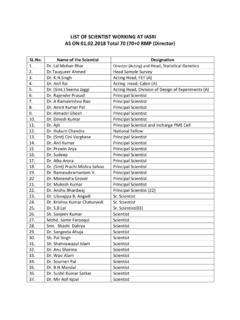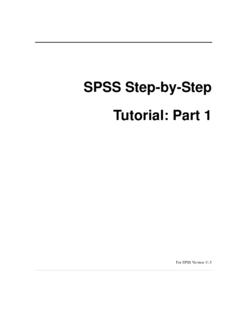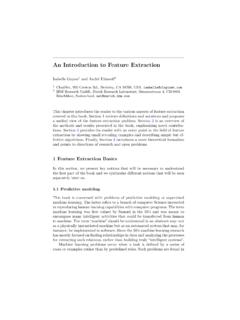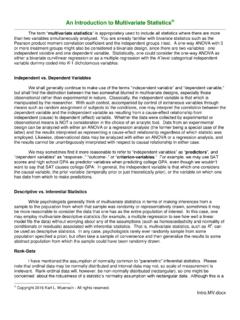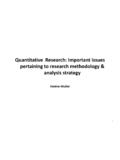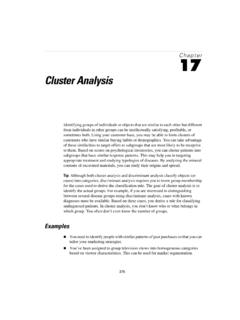Transcription of Data Preprocessing Techniques for Data Mining - IASRI
1 data Preprocessing Techniques for data Mining introduction data pre-processing is an often neglected but important step in the data Mining process. The phrase "Garbage In, Garbage Out" is particu larly applicab le to data Mining and machine learning. data gathering methods are often loosely controlled, resulting in out-of-range values ( , Income: -100), impossible data combinations ( , Gender: Male, Pregnant: Yes), miss ing values, etc. Analyzing data that has not been carefully screened for such problems can produce misleading results. Thus, the representation and quality of data is first and foremost before running an analysis. If there is much irrelevant and redundant information present or noisy and unreliable data , then knowledge discovery during the training phase is more difficult. data preparation and filtering steps can take considerable amount of processing time. data pre-processing includes cleaning, normalization, transformation, feature extraction and selection, etc.
2 The product of data pre-processing is the final train ing set. data Pre-processing Methods Raw data is highly susceptible to noise, missing values, and inconsistency. The quality of data affects the data Mining results. In order to help improve the quality of the data and, consequently, of the Mining results raw data is pre-processed so as to improve the efficiency and ease of the Mining process. data Preprocessing is one of the most critical steps in a data Mining process which deals with the preparation and transformation of the initial dataset. data Preprocessing methods are divided into following categories: data Cleaning data Integration data Transformation data Reduction data Preprocessing Techniques for data Mining Winter School on " data Mining Techniques and Tools for Knowledge Discovery in Agricultural Datasets 140 Figure 1: Forms of data Preprocessing data Cleaning data that is to be analyze by data Mining Techniques can be incomplete (lacking attribute values or certain attributes of interest, or containing only aggregate data ), noisy (containing errors, or outlier values which deviate from the expected), and inconsistent ( , containing discrepancies in the department codes used to categorize items).
3 Incomplete, noisy, and inconsistent data are commonplace properties of large, real-world databases and data warehouses. Incomplete data can occur for a number of reasons. Attributes of interest may not always be available, such as customer information for sales transaction data . Other data may not be included simply because it was not considered important at the time of entry. Relevant data may not be recorded due to a misunderstanding, or because of equipment malfunctions. data that were inconsistent with other recorded data may have been deleted. Furthermore, the recording of the history or modifications to the data may have been overlooked. Missing data , particularly for tuples with missing values for some attributes, may need to be inferred. data can be noisy, having incorrect attribute values, owing to the following. The data collection instruments used may be faulty. There may have been human or computer errors occurring at data entry.
4 Errors in data transmission can also occur. There may be technology lim itations, such as limited buffer size for coordinating synchronized data transfer and consumption. Incorrect data may also result data Preprocessing Techniques for data Mining Winter School on " data Mining Techniques and Tools for Knowledge Discovery in Agricultural Datasets 141 from inconsistencies in naming conventions or data codes used. Duplicate tuples also require data cleaning. data cleaning routines work to clean" the data by filling in missing values, smoothing noisy data , identifying or removing outliers, and resolving inconsistencies. Dirty data can cause confusion for the Mining procedure. Although most Mining routines have some procedures for dealing with incomplete or noisy data , they are not always robust. Instead, they may concentrate on avoiding over fitt ing the data to the function being modelled. Therefore, a useful pre-processing step is to run your data through some data cleaning routines.
5 Missing Values: If it is noted that there are many tuples that have no recorded value for several attributes, then the missing values can be filled in for the attribute by various methods described below: 1. Ignore the tuple: This is usually done when the class label is missing (assuming the Mining task involves class ification or description). This method is not very effective, unless the tuple contains several attributes with missing values. It is especially poor when the percentage of missing values per attribute varies considerably. 2. Fill in the missing value manually: In general, this approach is time-consuming and may not be feasible given a large data set with many missing values. 3. Use a global constant to fi ll i n the missing value: Replace all missing attribute values by the same constant, such as a label like \Unknown", or - . If missing values are replaced by, say, \Unknown", then the Mining program may mistakenly think that they form an interesting concept, since they all have a value in common | that of \Unknown".
6 Hence, although this method is simple, it is not recommended. 4. Use the attribute mean to fi ll in the missing value 5. Use the attribute mean for all samples belonging to the same class as the given tuple. 6. Use the most probable value to fill in the missing value: This may be determined with inference-based tools using a Bayesian formalism or decision tree induction. Methods 3 to 6 bias the data . The filled-in value may not be correct. Method 6, however, is a popular strategy. In comparison to the other methods, it uses the most information from the present data to predict missing values. Noisy data : Noise is a random error or variance in a measured variable. Given a numeric attribute such as, say, price, how can the data be smoothed" to remove the noise? The following data smoothing Techniques describes this. 1. Binning methods: Binning methods smooth a sorted data value by consulting the \neighborhood", or values around it. The sorted values are distributed into a number of 'buckets', or bins.
7 Because binning methods consult the neighborhood of values, they perform local smoothing values around it. The sorted values are distributed into a number of 'buckets', or bins. Because binning methods consult the neighborhood of values, they perform local smoothing. 2. Clustering: Outliers may be detected by clustering, where similar values are organized into groups or \clusters". data Preprocessing Techniques for data Mining Winter School on " data Mining Techniques and Tools for Knowledge Discovery in Agricultural Datasets 142 3. Combined computer and human inspection: Outliers may be identified through a combination of computer and human inspection. In one application, for example, an information-theoretic measure was used to help identify outlier patterns in a handwritten character database for classification. The measure's value reflected the \surprise" content of the predicted character label with respect to the known label.
8 Outlier patterns may be informative ( , identifying useful data exceptions, such as different versions of the characters \0" or \7"), or \garbage" ( , mislabeled characters). Patterns whose surprise content is above a threshold are output to a list. A human can then sort through the patterns in the list to identify the actual garbage ones. This is much faster than having to manually search through the entire database. The garbage patterns can then be removed from the (training) database. 4. Regression: data can be smoothed by fitting the data to a function, such as with regression. Linear regression involves finding the \best" line to fit two variables, so that one variable can be used to predict the other. Multiple linear regression is an extension of linear regression, where more than two variables are involved and the data are fit to a multidimensional surface. Using regression to find a mathematical equation to fit the data helps smooth out the noise.
9 Inconsistent data : There may be inconsistencies in the data recorded for some transactions. Some data inconsistencies may be corrected manually using external references. For example, errors made at data entry may be corrected by performing a paper trace. This may be coupled with routines designed to help correct the inconsistent use of codes. Knowledge engineering tools may also be used to detect the violation of known data constraints. For example, known functional dependencies between attributes can be used to find values contradicting the functional constraints. data Integration It is likely that your data analysis task will involve data integration, which combines data from multiple sources into a coherent data store, as in data warehousing. These sources may include multiple databases, data cubes, or flat files. There are a number of issues to consider during data integration. Schema integration can be tricky. How can like real world entities from multiple data sources be 'matched up'?
10 This is referred to as the entity identification problem. For example, how can the data analyst or the computer be sure that customer id in one database, and cust_number in another refer to the same entity? Databases and data warehouses typically have metadata - that is, data about the data . Such metadata can be used to help avoid errors in schema integration. Redundancy is another important issue. An attribute may be redundant if it can be \derived" from another table, such as annual revenue. Inconsistencies in attribute or dimension naming can also cause redundancies in the resulting data set. data Transformation In data transformation, the data are transformed or consolidated into forms appropriate for Mining . data transformation can involve the following: data Preprocessing Techniques for data Mining Winter School on " data Mining Techniques and Tools for Knowledge Discovery in Agricultural Datasets 143 1. Normalization, where the attribute data are scaled so as to fall within a small specified range, such as to , or 0 to 2.

